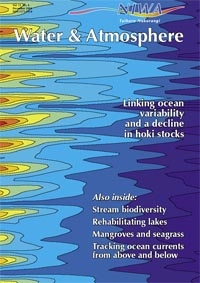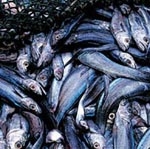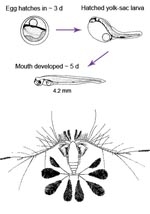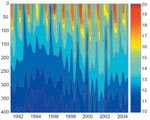PDF of this article (392 KB)

Janet Bradford-Grieve Mary Livingston Philip Sutton Mark Hadfield
Changing conditions in the Tasman Sea may have brought hard times for newly hatched hoki larvae.
Declining hoki stocks

Fisheries managers and fishers have become worried about the ongoing decline in the western stock of hoki. This stock is now estimated to be at about 13% of the biomass that existed before fishing developed for this species in 1972. The aspect of greatest concern is the poor year-class strength since 1995.
The western stock of hoki lives mainly on the Southern Plateau south of New Zealand and migrates to spawn off the Westland coast in winter. Hoki spawn in mid-water above the continental slope. The fertilised eggs take about 3 days to hatch into yolk-sac larvae. Within about 5 days the larvae develop into small, 4-mm-long fish capable of feeding.
At this stage the larval fishes’ favourite food is Calocalanus – small copepods about 1 mm long. These are oceanic, warm-water species that thrive just offshore from Westland under specific conditions. (See box below.)
Hoki food supply
What are the conditions that favour a sufficient population of Calocalanus to enable hoki larvae to grow quickly and thereby escape predation? Correlative studies have found a link between hoki larval survival and El Niño conditions of cool sea-surface temperatures and westerly winds. But what are the underlying mechanisms linking environmental conditions with abundant food supply?
In order to grow, phytoplankton depend on rapid recycling of nutrients from dead organic matter to inorganic form. During summer, the surface waters of the Tasman Sea off Westland are poor in nutrients (such as nitrates). When surface waters cool in autumn and winter, convective mixing occurs to deeper depths, bringing unused phytoplankton nutrients from deeper layers up into surface waters. The combination of higher nutrients and abundant light near the surface allows phytoplankton production to increase. This increased supply of phytoplankton is, in turn, grazed on by small animals such as Calocalanus. They begin to lay eggs, grow, and increase in numbers; then they are consumed by hoki larvae.
There are subtle year-to-year differences in the pattern of this winter deeper mixing that are largely weather driven (by temperature and wind). Our recent physical oceanographic studies in the Tasman Sea show that, as well as variability in weather, there is additional variability in the interior of the ocean with potentially far-reaching effects on hoki and their eventual entry into the fished population.
Our hypothesis
From 1996 to 2002 the Tasman Sea was much warmer than usual. Measurements showed that warming occurred down to at least 800 m. Because of a general relationship between temperature and nitrate with depth in subtropical waters, we can deduce that nitrate concentrations available to be mixed into surface waters in autumn and winter may have been lower during these years.
Our hypothesis is that one of the main factors governing recruitment to the western hoki stock is availability of nutrients, such as nitrate, to winter surface waters off Westland. A good survival of hoki larvae depends on an adequate, subsurface supply of nitrate, and an early start (at the beginning of July) to winter surface mixing.
It is always difficult to distinguish the relative effects of fishing and environmental change on fish population levels. By testing hypotheses such as this one, we can better understand the interactions over time. Without a solid understanding of the links between ocean conditions and the abundance of young fish, projections about future harvest levels of adult populations will be of limited value to fisheries managers. Stock-rebuilding strategies and harvest adjustment could take into account current and predicted climate patterns and oceanographic events that drive the mechanisms affecting hoki survival.
Development of larval hoki

In winter the western hoki stock population migrates from the Southern Plateau, southeast of New Zealand, to the west coast of South Island to spawn. The Hokitika Canyon seems to be a prime location, with the largest and most fecund fish aggregating densely to spawn in the canyon. Hoki eggs, which are about 1 mm in diameter, are positively buoyant, and float up towards the surface. The newly hatched larvae are about 2 mm long. After 5 days the yolk sac is almost completely absorbed and the mouth and intestinal tract opened. Top of the menu for newly hatched hoki larvae are small copepods of the genus Calocalanus, which may be very abundant in some years.
Declining western stocks

Fisheries managers and fishers are concerned about the recent decline in the western stock of hoki. Fish biomass is expected to decline to a level estimated to be around a size that will generate maximum sustainable yield (about 20% of the initial biomass). The most recent stock assessment estimates that the western stock is now at about 13% of the biomass that existed before fishing began (left panel); this is cause for concern and will lead to large cuts in the Total Allowable Catch. Year class strength (YCS) is the relative abundance of hoki spawned in a particular year. Of most concern is the below-average YCS since 1995 (right panel). The horizontal line represents average YCS.
(Graphs from Fishery Assessment Plenary Report, May 2004, p. 270. Click to enlarge)
Warming of the Tasman Sea

A joint project between NIWA, Scripps Institution of Oceanography (USA), and CSIRO (Australia) has revealed the deep warming of the Tasman Sea since 1996. This warming has coincided with a lack of recruitment of hoki into the adult population.
We think, but have not yet proved, that this warming has had a large effect on the supply of nutrients to the sea surface. The nitrate content of New Zealand waters is an obvious subject for further study. We need to investigate geographic and seasonal variability of nutrients with depth and determine the actual importance of the link between nitrate and food abundance.
Mixed-layer variation off Westland

We have used modelling to demonstrate the relationship between annual surface mixing (top panels) and nutrient supply to surface waters (bottom panels). Model results (black lines on graphs) compare relatively well with field observations (black spots).
In 1987, surface mixing increased surface nitrate to 1 µM (white line) by the beginning of July (red line) and then took several weeks to reach maximum mixed-layer depths. The mixed-layer deepening resulted in more nitrate, large phytoplankton cells, and greater densities of Calocalanus. Fish hatched in 1987 were strongly represented in the adult hoki population (that is, they became a strong year class) and are still being caught in low numbers today.
In contrast, in 1990, surface nitrate of 1 µM (white line) was attained nearly four weeks later, at the end of July (red line), then mixing progressed much more rapidly to maximum mixed-layer depths. Fish hatched in 1990 were poorly represented in adult populations. In 1990 the mixed layer contained low nitrate concentrations, phytoplankton cells were very small, and there were low densities of Calocalanus, compared with 1987 – too low to support the survival of hoki larvae.
Janet Bradford-Grieve, Philip Sutton, and Mark Hadfield are based at NIWA in Wellington. Mary Livingston works for the Ministry of Fisheries.
Teachers’ resource for NCEA AS: Biology 2.5, 3.2; Science 2.2, 3.2; Geography 3.1, 3.6. See other curriculum connections at www.niwa.co.nz/pubs/wa/resources
